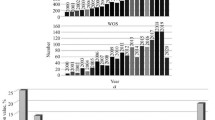Abstract
Spark plasma sintering is a method of consolidating nanostructured powder materials and also composites and gradient materials in the presence of an electromagnetic field, by means of low-voltage sources of powerful current. The main benefit of spark plasma sintering is that previously impossible structures, properties, and compositions may be produced. The finite-element method is used to analyze the consolidation of samples by spark plasma sintering and by a hybrid method in which spark plasma sintering is combined with hot pressing. Corresponding numerical models are tested.
Similar content being viewed by others
References
COMSOL Multiphysics v. 4.3a Material library.
Kolotyrkin, Ya.M. and Knyazheva, V.M., Itogi Nauki i Tekhniki, Seriya: Korroziya i Zashchita ot Korrozii (Achievements of Science and Technology, Corrosion and Corrosion Protection), Moscow: Vseross. Inst. Nauch. Tekh. Inform., Ross. Akad. Nauk, 1974, vol. 3.
Yang, H., Multi-field simulation of the spark plasma sintering process, Thesis in Engineering Mechanics, Philadelphia: Pa. State Univ., 2010.
Schunk–innovative insulation materials. http://www. ingenieurparadiesde/sixcms/mediaphp/1466/20_39e_ Innovative_Insulation_Materialspdf
Vanmeensel, K., Laptev, A., Hennicke, J., Vleugels, J., and van der Biest, O., Modeling of the temperature distribution during field assisted sintering, Acta Mater., 2005, vol. 53, pp. 4379–4388.
http://wwwilma-sealingcom/filephp?Grafitovaya_ folga_Sigraflex-gid-121-136-416pdf
Tiwari, D., Basu, D., and Biswas, K., Simulation of thermal and electric field evolution during spark plasma sintering, Ceram. Int., 2009, no. 35, pp. 699–708.
Vanmeensel, K., Laptev, A., van der Biest, O., and Vleugels, J., Field assisted sintering of electro-conductive ZrO2-based composites, J. Eur. Ceram. Soc., 2007, no. 27, pp. 979–985.
Zhang, J., Numerical simulation of thermoelectric phenomena in field activated sintering, PhD Thesis, Philadelphia, PA: Drexel Univ., 2004.
Khaleghi, E.A., Tailored net-shape powder composites by spark plasma sintering, PhD Dissertation in Engineering Science, San Diego, CA: Univ. of California, 2012.
Ruskola, M., Numerical modeling of pulsed electric current sintering process, MSc Thesis in Technology, Espoo, Finland: Aalto Univ., 2014.
Voisina, T., Duranda, L., Karnatakbat, N., Galletc, S.L., Thomasd, M., Le Berree, Y., Castagnef, J.F., and Coureta, A., Temperature control during spark plasma sintering and application to up-scaling and complex shaping, J. Mater. Process. Technol., 2013, no. 213, pp. 269–278.
Wang, C., Cheng, L., and Zhao, Z., FEM analysis of the temperature and stress distribution in spark plasma sintering: modeling and experimental validation, Comput. Mater. Sci., 2010, no. 49, pp. 351–362.
Dmitriev, A.M., Korobova, N.V., and Tolmachev, N.S., Experimental verification of the results of computer simulation of the stresses on the element of deforming tool, Vestn. Mosk. Gos. Tekhnol. Univ., Stankin, 2014, no. 2(29), pp. 44–49.
Kalyakulin, S.Yu. and Kuz’min, V.V., Development of mathematical model of technological process parameters, Vestn. Mosk. Gos. Tekhnol. Univ., Stankin, 2014, no. 3 (30), pp. 40–44.
Kabak, I.S., Neural network model for forecasting and assessment of software reliability, Vestn. Mosk. Gos. Tekhnol. Univ., Stankin, 2014, no. 1 (28), pp. 107–111.
Bolbukov, V.P., Regulation of the energy of fast gas atoms by change in the resistor strength, located between the working chamber and the emission grid of a source, Vestn. Mosk. Gos. Tekhnol. Univ., Stankin, 2014, no. 3 (30), pp. 54–57.
Sobolev, A.N., Kosov, M.G., and Nekrasov, A.Ya., Simulation of construction of the body parts using the estimated trace elements, Vestn. Mosk. Gos. Tekhnol. Univ., Stankin, 2014, no. 3 (30), pp. 98–10.
Kozochkin, M.P. and Solis Pinargote, N.W., Analysis of the effects of vibration turning using coolants, Vestn. Mosk. Gos. Tekhnol. Univ., Stankin, 2014, no. 4 (31), pp. 67–73.
Frolov, E.B., Kryukov, V.V., and Kryukov, A.V., Integration of the systems of automated design of technological processes and operational industrial systems based on control database formation, Vestn. Mosk. Gos. Tekhnol. Univ., Stankin, 2014, no. 4 (31), pp. 133–139.
Grigor’ev, S.N., Kuzin, V.V., Fedorov, S.Yu., Tibor Szalay, and Balazs Farkas, Technological aspects of the electrical-discharge machining of small-diameter holes in a high-density ceramic. Part 1, Refract. Ind. Ceram., 2014, vol. 55, no. 4, pp. 330–334.
Kuzin, V.V., Grigor’ev, S.N., and Ermolin, V.N., Stress inhomogeneity in a ceramic surface layer under action of an external load. Part 1. Effect of complex mechanical loading, Refract. Ind. Ceram., 2014, vol. 54, no. 5, pp. 416–419.
Kuzin, V.V., Grigor’ev, S.N., and Ermolin, V.N., Stress inhomogeneity in a ceramic surface layer under action of an external load. Part 2. Effect of thermal loading, Refract. Ind. Ceram., 2014, vol. 54, no. 6, pp. 497–501.
Kuzin, V.V., Grigor’ev, S.N., and Ermolin, V.N., Stress inhomogeneity in a ceramic surface layer under action of an external load. Part 3. Effect of a distributed force load, Refract. Ind. Ceram., 2014, vol. 55, no. 1, pp. 36–39.
Kuzin, V.V., Grigor’ev, S.N., and Ermolin, V.N., Stress inhomogeneity in a ceramic surface layer under action of an external load. Part 4. Combined effect of force and thermal loads, Refract. Ind. Ceram., 2014, vol. 55, no. 1, pp. 40–44.
Author information
Authors and Affiliations
Corresponding author
Additional information
Original Russian Text © A.V. Smirnov, D.I. Yushin, N.W. Solis Pinargote, P.Yu. Peretyagin, R. Torrecillas, 2015, published in STIN, 2015, No. 8, pp. 34–40.
About this article
Cite this article
Smirnov, A.V., Yushin, D.I., Solis Pinargote, N.W. et al. Spark plasma sintering of nanostructured powder materials. Russ. Engin. Res. 36, 249–254 (2016). https://doi.org/10.3103/S1068798X16030163
Published:
Issue Date:
DOI: https://doi.org/10.3103/S1068798X16030163



